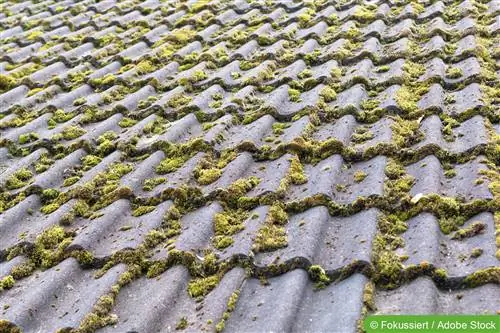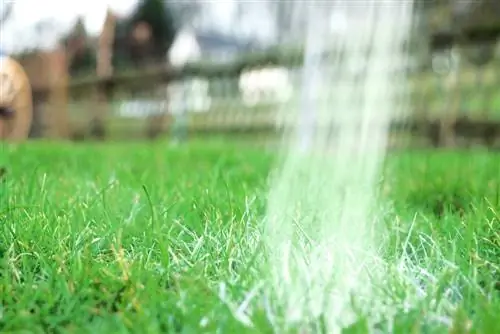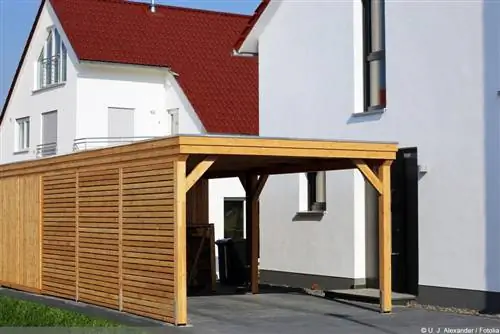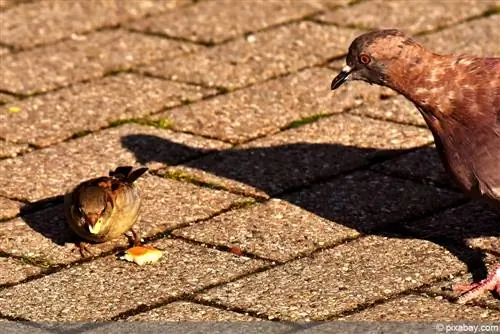- Author admin [email protected].
- Public 2023-12-17 03:39.
- Last modified 2025-01-24 12:45.
All areas also require regular cleaning and removal of moss and algae.
Disturbing moss “patina” on the roof, terrace and balcony
Balconies and terraces can be an oasis of relaxation, but they also need a thorough cleaning from time to time. Especially after the winter months, it is important to remove moss from outdoor areas. When nature awakens, unwanted green often appears in the cracks of the flooring. Due to the humidity that prevails in winter, moss and algae have accumulated there. The unwanted growth will increase over the next three or four months. Some stones get an interesting patina from the moss, but others look really unsightly. In addition, the slippery stones can also pose a risk of accidents.
If you want to continue to use the freedom of movement on your terrace, you should clean paving and slabs. Moss and algae can be contained in advance. Compared to sandstone, granite is less susceptible to moss formation. In addition, a slope can be installed when laying the panels so that the water does not build up and flows away more quickly.
Treatment options
- Chemicals
- Home remedies
- Scrape off
- Flamming
- High-pressure cleaner
- potassium permanganate
- Iron sulfate
Removal of moss at the green stage with a natural agent can be done on all easily accessible surfaces where a cleaning brush can also be used. Scratching away with steel blades and joint scrapers is also possible on balconies and terraces. The growth is scraped out with the roots. The green deposits can be scrubbed away with a joint brush with metal bristles or bristles made of hard plastic. With tools like these, the moss can also be removed from narrow joints.
Procedure for easily accessible areas
To do this, dissolve soda (sodium carbonate) in hot water, spray the mixture onto the affected area, let the mixture work briefly and then brush it off. By the way, this is a pleasantly inexpensive solution; a kilogram of washing soda costs around one euro in the supermarket.
Remaining residue can be removed with a scraper or scrubber, depending on the surface. In any case, greenish deposits should also be removed from any existing joints so that they do not constantly re-seed. The recommended tool for this is a narrow spatula or a narrow chisel the width of the joint when it comes to earth joints. A fine wire brush helps with mortar joints, and small gaps between patio stones can be easily worked on with a narrow chisel.
Remove thicker moss from the terrace or balcony
Manual work is initially used to remove thick moss cushions on terraces and balconies. The moss coverings or moss pads are scraped from the surface using a scraper with a smooth edge, then swept up with a broom and disposed of. The moss can be disposed of with organic waste, even if there are still residues of the soda mixture on it.
Remember not to add the removed moss to the compost, it would rot, but you would also be able to sow it again in your garden using the compost soil. This is not the case if your compost develops hot rot, i.e. temperatures above 50 degrees. Then the seeds die.
Soda can be used again to remove the residue, which is then rinsed with a damp cloth. Whatever can be picked up with a wiping device is removed and finally rinsed again with water.
Chemical club against moss
A wide range of chemicals are available commercially to remove unwanted growth. However, that does not mean that the use of these resources is always permitted. Plant protection products and pesticides are prohibited on paved areas. They are poisonous and extremely harmful to fish, for example. Only the use of agents that are expressly approved for plate cleaning is permitted. Green deposit removers are generally classified as environmentally harmful. Iron sulfate destroys moss on the lawn, but is not suitable for paving tiles on balconies and terraces.
For hard-to-reach areas, professional moss and algae remover can be used by spraying it or applying it with a lance. It causes the moss to die, which can then be vacuumed up with a construction vacuum cleaner or swept up with a broom. However, it can take some time for the moss to die, so please do not become impatient.
If there is still moss left, a second treatment is necessary. You can get detailed information from your garden center; if you cannot reach the area safely, there is also professional help to remove moss from the roof.
Proven home remedies for removing moss
If you want to take the environment into account, use tried and tested home remedies:
- Vegar and citric acid help with slight greening, but the effect does not last long.
- Iron sulfate is often used to combat moss on the lawn, but is not suitable for tiles, stones and slabs.
- The most environmentally friendly method is still a broom, brush and mop.
- Warm water with detergent is suitable. Likewise vinegar water or s alt, which is sprinkled between the joints.
- Chemical agents should be avoided on a wooden terrace, otherwise the material can become stained.
Removing moss with gas
An effective method is flashing with an infrared heater or gas. The plants are burned down with their roots using a kind of small flamethrower. Such a device is available at hardware stores for around 30 euros. However, this requires a lot of patience. The warmth stimulates the germination of seeds that are still in the soil. For this reason, some treatments are required within a very short period of time. Afterwards, the desired and long-term success will occur.
High pressure against moss
High-pressure cleaners are also quite environmentally friendly. They are available with special attachments and splash guards so that edges and corners can be reached when cleaning. Paths and terraces are practically cleaned at the same time. The terrace or balcony can be cleaned with minimal effort. If the weather is dry, the panels should be brushed beforehand; after high-pressure cleaning, it is recommended to refill the joints with sand. High-pressure cleaners are available from just 100 euros, depending on performance and scope of delivery.
Moss on the roof

Moss not only forms in the garden, on the terrace or balcony, this unpleasant phenomenon can also be discovered on the roof. It mainly forms in shady places and can become a problem over time. Not only is the unsightly appearance annoying, the moss infestation can hinder the drainage of rainwater, and in the worst case, the water penetrates up to the roof. If the coating is greenish, it is algae growth, which is usually not a problem and does not need to be removed. Lichens and mosses, on the other hand, form a cushion. To prevent them from being washed away and clogging the gutter, they should be removed.
For cleaning the roof area you need:
- High-pressure cleaner
- Special remedies
- Broom
- Spatula
- Pressure Sprayer
- Copper bands
If the roof is cleaned with a high-pressure cleaner, care must be taken not to damage the surface. In addition, you should only spray from top to bottom so that no cleaning water can get under the roof. High-pressure cleaning roughens the roof surface and recoating is recommended. Otherwise there is a risk that the moss will set in again much more quickly. Large moss pads must first be lifted off by hand with a spatula or swept away with a broom. Chemical agents for roof cleaning are applied using a pressure sprayer. Moss, algae and lichens on the roof are killed by copper sulfate. It is ideal to attach copper strips along the roof ridge. Together with acid rain, it forms the sulfate and the roof is permanently coated with it. In general, it is sufficient to occasionally remove the thick moss pads.
Conclusion
Whatever method is used to remove moss from balconies, terraces and roofs is up to each individual. Creating completely moss-free areas takes a lot of time and work, but is not absolutely necessary. Roughly removing moss and algae is completely sufficient, the rest is a matter of individual opinion.






